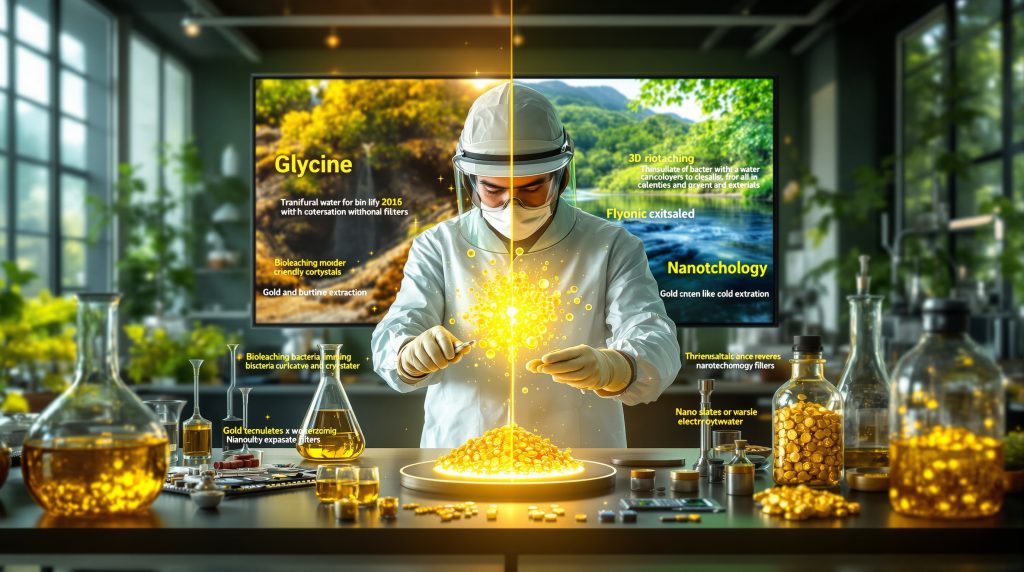Green Gold Extraction: Sustainable Methods for Modern Mining
Understanding the Concept of Sustainable Gold Recovery
Green gold extraction represents a fundamental shift in how we recover precious metals from the earth. These environmentally responsible techniques aim to minimize ecological damage while maintaining efficient gold recovery rates. Unlike conventional mining approaches, sustainable methods replace toxic processes with eco-friendly alternatives that protect ecosystems and human health without sacrificing economic viability.
The concept extends beyond merely reducing chemical use to encompass water conservation, energy efficiency, and waste minimization. According to the United Nations Environment Programme, truly sustainable gold recovery must address the entire extraction lifecycle, from initial mining through processing and eventual site restoration through mine reclamation evolution.
The Environmental Impact of Traditional Gold Extraction
Conventional gold mining has created a troubling environmental legacy across the globe. The industry has historically relied on mercury amalgamation and cyanide leaching—processes that have contaminated countless waterways, degraded soil quality, and harmed wildlife populations.
These legacy methods have caused extensive ecological damage in mining regions worldwide. Mercury used in artisanal and small-scale gold mining (ASGM) represents approximately 37% of global mercury emissions according to UNEP's 2018 Global Mercury Assessment, making it the largest source of anthropogenic mercury pollution globally. This contamination creates lasting environmental challenges that persist long after mining operations cease, driving the urgent need for greener alternatives.
How Does Traditional Gold Extraction Work?
The Science Behind Conventional Gold Recovery
Gold extraction traditionally follows a multi-stage process beginning with crushing and grinding ore to increase surface area for chemical reactions. What was once accomplished with simple stamp mills has evolved to sophisticated ball mills and SAG (Semi-Autogenous Grinding) mills that achieve micron-level fineness—a critical factor for efficient gold recovery.
The process continues with concentration, where valuable minerals are separated from waste rock. This stage employs various techniques depending on the ore characteristics. Physical separation methods exploit gold's remarkable density (19.3 g/cm³, approximately 19 times heavier than water) to separate it from lighter gangue minerals typically weighing just 2.6-2.7 g/cm³. Meanwhile, chemical processes target gold that's chemically bound to other minerals.
Before further processing, careful analysis guides metallurgists toward optimal recovery methods. Modern laboratories employ techniques like fire assay, X-ray diffraction (XRD), and inductively coupled plasma mass spectrometry (ICP-MS) to determine precise mineral composition and gold content, even at trace levels.
Limitations of Conventional Extraction Methods
While effective at recovering gold, traditional methods face significant drawbacks that make them increasingly problematic in a sustainability-conscious world. These limitations include extraordinarily high water consumption—research published in the Journal of Cleaner Production indicates conventional operations can use 250,000-500,000 liters of water per kilogram of gold produced.
Additional concerns include intensive energy requirements, toxic chemical dependency, and substantial waste generation. Conventional processing creates massive volumes of tailings that must be properly contained to prevent environmental contamination. These drawbacks have spurred mining industry innovation toward more sustainable approaches that maintain or improve recovery rates while reducing environmental footprints.
Why Are Mercury-Free Gold Extraction Methods Important?
Environmental and Health Hazards of Mercury
Mercury amalgamation, once widely used in artisanal mining, poses severe environmental and health risks. The process releases toxic vapors during heating and contaminating waterways when improperly handled. This potent neurotoxin bioaccumulates in food chains, causing progressively higher concentrations as it moves up through the ecosystem.
The health consequences are particularly severe in developing regions where regulatory oversight is limited. According to the World Health Organization, mercury exposure from ASGM activities affects an estimated 10-15 million miners and their families globally, with children particularly vulnerable to developmental disorders. Research published in Environmental Research Letters found mercury contamination from gold mining in the Amazon Basin has affected indigenous communities up to 400 kilometers downstream from mining sites.
The Global Movement Toward Mercury Elimination
International initiatives like the Minamata Convention on Mercury have established frameworks for phasing out mercury use in gold mining. This landmark treaty, which entered into force in 2017 and now has 137 participating nations, represents a global commitment to eliminating mercury use in ASGM and other industries.
The convention has accelerated the development and implementation of mercury-free alternatives that protect both miners and ecosystems. Governments, NGOs, and mining companies worldwide are collaborating to introduce cleaner technologies to artisanal miners, demonstrating that profitable gold recovery is possible without this dangerous neurotoxin.
What Makes Cyanide-Free Gold Recovery Revolutionary?
The Problem with Cyanide Leaching
Despite its effectiveness in dissolving gold, sodium cyanide presents serious environmental risks through potential spills, wildlife poisoning, and long-term soil contamination. While the industry has developed protocols to minimize these risks, catastrophic failures continue to occur.
Major cyanide-related mining disasters have prompted stringent regulations and catalyzed the search for safer alternatives. Notable incidents include the 2000 Baia Mare disaster in Romania, where 100,000 cubic meters of cyanide-contaminated water spilled into the Tisza River, and the 1995 Omai disaster in Guyana that released 3.2 million cubic meters of contaminated tailings into the environment. These events prompted the European Union to implement stricter regulations, with some member states banning cyanide use in mining entirely.
Emerging Non-Toxic Leaching Alternatives
Recent innovations have produced several promising cyanide replacements that can effectively dissolve gold with significantly reduced environmental risk profiles. These alternatives include thiosulfate, amino acids like glycine, and various plant-derived compounds that form stable, water-soluble complexes with gold.
Research published in the journal Hydrometallurgy demonstrates glycine's potential, with laboratory-scale studies showing gold recovery rates of 85-95% from certain ore types under optimized conditions. These biodegradable compounds can be easily recycled and operate effectively at moderate temperatures and pressures, potentially revolutionizing waste management solutions while maintaining competitive recovery rates.
Which Green Extraction Methods Are Transforming the Industry?
Gravity-Based Separation Techniques
Modern gravity concentration systems have evolved dramatically from simple panning to sophisticated equipment like centrifugal concentrators and spiral separators. These chemical-free methods exploit gold's high density (19.3 g/cm³) to achieve separation without harmful reagents, making them ideal for free-milling ores with visible gold particles.
Today's gravity recovery systems include Knelson and Falcon centrifugal concentrators that use rotational force to separate heavy gold particles from lighter materials. These technologies can recover gold particles as small as 30 microns while consuming minimal water and energy. For environmentally sensitive areas, these physical separation methods provide a chemical-free alternative that eliminates toxicity concerns while maintaining impressive recovery rates.
Thiosulfate Leaching Systems
Thiosulfate offers a non-toxic alternative to cyanide that forms soluble complexes with gold ions. This approach has proven particularly effective for certain refractory ores resistant to conventional cyanidation, opening new possibilities for processing complex ore bodies without harmful chemicals.
Commercial implementation of thiosulfate leaching by major mining companies in Nevada has demonstrated the viability of industrial-scale, cyanide-free gold production. While the process requires careful optimization to control reagent consumption, its environmental benefits make it increasingly attractive as regulatory pressures on cyanide use continue to increase worldwide.
Bioleaching and Microbial Extraction
This innovative approach harnesses naturally occurring bacteria like Acidithiobacillus ferrooxidans to break down sulfide minerals that encapsulate gold particles. The microorganisms essentially "digest" the mineral matrix, exposing gold for subsequent recovery methods. While slower than chemical processes, bioleaching requires minimal energy input and eliminates toxic reagents.
Several commercial-scale operations utilize bacterial oxidation through processes like BIOX®, developed for treating refractory sulfide concentrates. According to research published by CSIRO, these bioleaching operations can achieve gold recovery rates comparable to conventional methods while dramatically reducing chemical use and environmental impact, particularly for complex ore bodies once considered too difficult to process economically.
Glycine-Based Leaching Processes
Glycine, a naturally occurring amino acid, has emerged as a promising leaching agent that forms stable, water-soluble complexes with gold under alkaline conditions. This biodegradable compound can be easily recycled and operates effectively at moderate temperatures and pressures, potentially revolutionizing sustainable metallurgy.
Laboratory research demonstrates glycine's effectiveness, particularly when combined with low concentrations of hydrogen peroxide as an oxidant. The process works well for various gold-bearing materials, including electronic waste, making it a versatile solution for both primary mining and urban mining applications. Its non-toxic nature presents significant advantages for operations near sensitive ecosystems or water sources.
How Do Plant-Based Extraction Methods Work?
Traditional Botanical Knowledge in Modern Mining
Indigenous communities across Africa and South America have long used plant extracts to recover gold. These traditional techniques create foamy, sticky mixtures that effectively trap fine gold particles by altering water surface tension. Modern research is now validating and optimizing these approaches for broader application.
Various plants contain natural saponins and other compounds that create stable foams capable of capturing gold particles through physical adsorption. These botanical methods represent a remarkable example of traditional knowledge offering solutions to modern environmental challenges. As interest in chemical-free extraction grows, ethnobotanical research is identifying the specific compounds and mechanisms responsible for these plant-based recovery systems.
Case Study: Colombia's "Green Gold" Initiative
Colombian miners have implemented plant-based extraction methods that eliminate mercury use while maintaining comparable gold recovery rates. This initiative has not only reduced environmental contamination but also created premium-priced "green gold" products that command higher market values due to their ethical production methods.
The approach uses specific plant extracts in specialized washing systems to create foams that selectively capture gold particles. Local miners report recovery rates similar to traditional mercury-based methods, but with zero mercury emissions. This dual benefit of environmental protection and market premium demonstrates how mining sustainability transformation can create economic advantages in addition to ecological benefits.
What Role Does Nanotechnology Play in Sustainable Gold Recovery?
Gold-Selective Nanoparticles
Advanced nanomaterials engineered with specific surface properties can selectively bind with gold ions in solution. These "molecular magnets" effectively capture gold from dilute or complex solutions that were previously uneconomical to process, enabling recovery from new sources with minimal environmental impact.
Research in materials science journals reveals several promising nanoparticle designs, including functionalized silica, magnetic nanocomposites, and polymer-based materials with gold-specific binding sites. These technologies can potentially recover gold from solutions containing just a few parts per million, opening new frontiers in gold recovery from low-grade sources and waste streams that conventional methods cannot economically process.
Nano-Enhanced Recovery Systems
Emerging extraction systems combine nanotechnology with traditional processes to improve gold recovery while reducing chemical consumption. These hybrid approaches may represent the next frontier in balancing efficiency with environmental responsibility, particularly for complex or refractory ore types.
Laboratory studies demonstrate that adding specific nanoparticles to conventional leaching systems can accelerate dissolution rates and increase gold recovery while reducing reagent consumption. While still emerging, these technologies could potentially offer significant improvements in both recovery rates and environmental performance as they mature from laboratory to commercial scale.
How Is Electronic Waste Becoming the New Gold Mine?
Urban Mining Potential
Electronic waste contains gold concentrations often exceeding those found in natural ores. According to research published in the Journal of Hazardous Materials, while typical gold ore contains 5-10 grams per tonne, circuit boards can contain 200-250 grams per tonne—a 40-50x concentration. With billions of devices discarded annually, e-waste represents a significant secondary gold resource.
The United Nations University estimates approximately 50 million tonnes of e-waste were generated globally in 2019, containing roughly 50 tonnes of gold. This "urban mine" offers an opportunity to recover valuable materials while reducing both primary mining impacts and waste accumulation. As device lifespans shorten and electronics consumption grows, this resource stream continues to expand globally.
Green Methods for E-Waste Gold Recovery
Innovative biochemical and electrochemical techniques are replacing harsh acid treatments traditionally used in e-waste processing. These methods selectively dissolve and recover gold with minimal energy consumption and chemical waste, transforming urban waste streams into valuable resource flows.
Emerging technologies include selective leaching with mild reagents, biosorption using microorganisms to capture gold ions, and advanced electrochemical recovery systems. These processes can achieve high recovery rates while generating significantly less hazardous waste than conventional methods. As regulatory pressure on e-waste management increases worldwide, these sustainable recovery methods are becoming increasingly important.
What Innovations Are Driving the Future of Green Gold Extraction?
Artificial Intelligence and Process Optimization
Machine learning algorithms are revolutionizing gold recovery by predicting ore characteristics, optimizing reagent usage, and monitoring environmental parameters in real time. According to McKinsey & Company's 2019 report on digital transformation in mining, AI and analytics can reduce operational costs by 10-20%, improve recovery rates by 5-10%, and decrease water usage by 20-30%.
These systems reduce waste, minimize chemical consumption, and lower the overall carbon footprint of mining operations. Advanced sensor networks feed data to AI systems that continuously optimize extraction parameters, ensuring maximum efficiency while maintaining environmental compliance. This data-driven approach represents a fundamental shift from fixed processing methods to dynamic, responsive systems tailored to each batch of material.
Closed-Loop Water and Energy Systems
Sustainable gold extraction increasingly incorporates water recycling technologies that dramatically reduce freshwater consumption. Modern operations aim to minimize water intake by treating and reusing process water, greatly reducing their impact on local water resources.
Similarly, renewable energy sources like solar and hydrogen power are replacing fossil fuels at remote mining sites. These clean energy transitions cut greenhouse gas emissions without compromising productivity. Several major mining companies have announced ambitious renewable energy targets, recognizing both the environmental benefits and decarbonisation benefits of transitioning away from diesel generators and grid electricity.
Phytomining Developments
Experimental approaches using specific plants to absorb trace gold from soil show promise as ultra-low-impact recovery methods. These hyperaccumulator plants concentrate gold in their tissues and are later harvested and processed to recover the metal, potentially enabling gold recovery with minimal ecological disruption.
Research documented in journals like Plant and Soil demonstrates the ability of certain plant species to accumulate gold from soil containing just a few parts per million. While commercial application remains experimental, this biologically-based approach could eventually provide a way to extract gold from low-grade sources with near-zero environmental impact, representing the ultimate convergence of biology and metallurgy.
How Can Miners Transition to Green Gold Extraction?
Economic Considerations and Implementation Challenges
While green extraction methods offer environmental benefits, miners must navigate implementation costs, process adjustments, and potential recovery rate changes. The transition often requires capital investment, technical training, and operational modifications that present short-term challenges despite long-term advantages.
These economic factors include initial equipment purchases, facility modifications, and process optimization periods. However, long-term benefits typically include reduced chemical purchases, lower waste management expenses, decreased remediation liabilities, and potential access to premium markets for responsibly sourced gold. Forward-thinking operations view these transitions as strategic investments rather than mere compliance costs.
Regulatory Frameworks and Market Incentives
Evolving regulations increasingly favor or mandate sustainable extraction methods. Simultaneously, premium pricing for responsibly produced gold creates market incentives that can offset transition costs and reward early adopters of green technologies.
Certification programs like Fairmined, Fairtrade Gold, and the Responsible Jewellery Council provide frameworks for verifying environmentally responsible gold production. These certifications enable producers to access premium markets and demonstrate their commitment to sustainable practices. As consumer awareness of mining impacts grows, the market advantage for certified sustainable gold continues to strengthen, creating financial incentives aligned with environmental goals.
FAQ: Green Gold Extraction Methods
What makes gold extraction "green"?
Green gold extraction methods minimize or eliminate toxic chemicals like mercury and cyanide while reducing water and energy consumption. These sustainable approaches limit waste generation and employ biodegradable or recyclable reagents to recover gold with minimal environmental impact. The goal is to maintain efficient recovery while protecting ecosystems, water resources, and human health throughout the extraction process.
Are green extraction methods as effective as traditional ones?
Many green methods achieve comparable recovery rates to traditional techniques, particularly when tailored to specific ore types. While some alternative processes may have slightly lower recovery percentages for certain materials, this is often balanced by reduced environmental costs, regulatory compliance, and potential premium pricing for responsibly produced gold.
Modern gravity concentration systems, thiosulfate leaching, and bioleaching have all demonstrated commercial viability across various ore types. The key is matching the right green technology to the specific mineralogical characteristics of each deposit.
How do green extraction methods affect mining economics?
While initial implementation may require investment, green methods often reduce long-term costs through decreased chemical purchases, lower waste management expenses, reduced remediation liabilities, and potential access to premium markets for responsibly sourced gold.
Mining operations transitioning to sustainable methods typically see improved community relations, simplified permitting processes, and reduced environmental compliance costs. Many companies report that after the initial transition period, operating costs stabilize at levels comparable to or lower than conventional methods when considering the full lifecycle costs.
Can small-scale miners adopt green extraction technologies?
Several green technologies are specifically designed for artisanal and small-scale mining operations. Plant-based methods, gravity concentration, and certain chemical alternatives can be implemented with minimal capital investment while significantly reducing environmental impact.
Organizations focused on sustainable mining have developed specialized equipment and training programs specifically for small-scale operations. These adaptations make sustainable technologies accessible even in remote or resource-limited contexts, demonstrating that green gold recovery isn't limited to large corporations with substantial capital.
What role does certification play in green gold production?
Certification programs like Fairmined, Fairtrade Gold, and the Responsible Jewellery Council provide frameworks for verifying environmentally responsible gold production. These certifications enable producers to access premium markets and demonstrate their commitment to sustainable practices.
By establishing transparent standards and verification procedures, these programs create market incentives for adopting green extraction methods. Certified gold typically commands premium prices in jewelry and investment markets, helping offset the costs of implementing more sustainable technologies and practices.
Further Exploration
The transition toward green gold extraction represents one of the mining industry's most significant shifts in centuries. As technology advances and environmental awareness grows, these sustainable methods continue to evolve, demonstrating that responsible resource extraction and profitability can coexist.
For those interested in deeper understanding, numerous educational resources explore the science behind sustainable gold recovery, from academic research in journals like Hydrometallurgy and Minerals Engineering to practical demonstrations of mercury-free processing techniques designed for small-scale miners.
The future of gold extraction lies in balancing humanity's continued desire for this precious metal with our growing commitment to environmental stewardship—a challenge that green extraction methods are increasingly equipped to meet.
Want to Invest in ASX Companies Pioneering Sustainable Mining?
Stay ahead of the market with Discovery Alert's proprietary Discovery IQ model, which instantly notifies you when ASX-listed companies announce significant mineral discoveries or sustainable mining breakthroughs. Visit our discoveries page to understand how environmentally responsible mining companies can deliver exceptional returns while transforming the industry.




